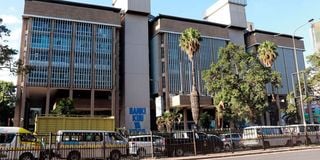Deposit rates hit four-year high as banks woo the rich

Central Bank of Kenya headquarters in Nairobi.
Commercial banks have sharply raised the interest on fixed deposits to woo new funds on tightened liquidity in the market.
Banks raised the average deposit rate to 7.54 per cent in February, data from the Central Bank of Kenya (CBK) shows, the highest since 8.04 per cent in June 2018.
Usually, cash-rich firms and individuals dominate the fixed deposit market where most accounts have millions of shillings locked up for months to one year.
Banks don’t pay interest on most savings accounts, with those that do earning substantially lower rates than those on fixed deposit accounts.
The jump in deposit rates is a signal that banks are ready to raise funds to lend more on increased economic resurgence as Kenya continues to recover from the aftershocks of the Covid-19 pandemic.
Banks depend on several sources of funds to support their lending business. These include retained profits and borrowed money, including fixed deposits.
The rise in the fixed deposit rates comes amid tightened liquidity in the market due to a rise in base lending rates and subsequent short-term government securities rates as banks are forced to attract larger depositors to keep their money with them instead of lending to the State.
The rate at which banks lend to each other — interbank rate —has also jumped to 8.03 per cent on April 5, five years and three-month high since December 17, 2018, when it was recorded at 10.17 per cent.
The tight liquidity is on the back of a rise in the base lending rate to the highest level in five years to curb inflation.
The Central Bank Rate (CBR) was increased to 9.50 per cent in March from 8.75 per cent triggering banks to raise their lending rates.
High returns on short-term government securities signal a preference for lending to the State rather than the private sector due to the low-risk nature of the investment.
The lending rate was recorded at 13.06 per cent in February, the highest rate since the same period in June 2018, when it was 13.22 per cent.
Liquidity in the money market increased during the week ended April 5 as government payments more than offset tax remittances.
Commercial banks’ excess reserves stood at Sh9.5 billion in relation to the 4.25 per cent cash reserves requirement.
The average interbank rate was 8.03 per cent on April 5 compared to 7.69 per cent on March 30.
During the week, the average number of interbank deals increased to 39 from 33 the previous week, while the average value traded increased to Sh 26.1 billion from Sh 20.6 billion.





